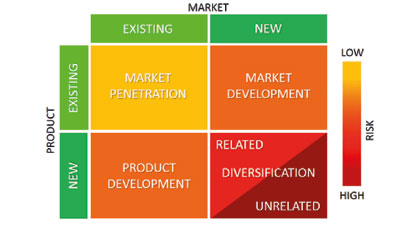“Existing – New” Strategic Options in Tackling Market Pressure
View(s): The Ansoff matrix was introduced by Igor Ansoff in 1965 and is used to develop strategic options for businesses. It is one of the most used tools for this type of analysis due to its simplicity and ease of use. It’s so simple to apply for any context and to any business as it paves the way to see options available in increasing sales for the business. It’s important for someone to know that even though it shows alternate actions and avenues that are available for revenue growth, there is no indication of the profits which can be generated through the available options.
The Ansoff matrix was introduced by Igor Ansoff in 1965 and is used to develop strategic options for businesses. It is one of the most used tools for this type of analysis due to its simplicity and ease of use. It’s so simple to apply for any context and to any business as it paves the way to see options available in increasing sales for the business. It’s important for someone to know that even though it shows alternate actions and avenues that are available for revenue growth, there is no indication of the profits which can be generated through the available options.
As the diagram indicates, the matrix will open up new avenues to think in developing any business. This has to be coupled with channel development for any organisation to get the benefits.
Market Penetration (Existing Product – Existing Market)
This strategy focuses on increasing the volume of sales of existing products to the organisation’s existing market. Questions asked:
How can we defend our market share?
How can we grow our market?
In today’s context in Sri Lanka, it must be extremely difficult for organisations to defend their market share or to grow the market as the market is shrinking due to various macroeconomic factors which are having an adverse effect on businesses regardless of which sector or industry it is. However, the areas to look at are:
1. Increasing avenues of selling more to current customers –
2. Getting back lost customers or lapsed customers
3. Cross-selling and upselling to existing customers –
Option 2 and 3 are mostly applicable for the services sector (Such as banks, insurance companies, hotels, vehicle repair centers, salons, etc.)
Product Development (Existing Market – New Product)
This strategy focuses on reaching the existing market with new products. Questions asked:
- How can we expand our product portfolio by modifying or creating products?
- How can we develop an innovation pipeline for future markets?
- How can we reduce the “time-to-market” in the New Product Development (NPD) Process?
As 90% of new products are bound to fail in the market there is a risk in launching new products to the market. However, in the recent past it’s evident that certain organisations have begun to practice, TRY FAST – FAIL FAST to avoid the delays brought into the system due to inherent issues in the NPD processes. This will also pave the way to cut down on the “time-to-market” which is a pain point for any marketing or brand manager. The real challenge with NPD is the quest for investment in branding as the launch of a new product needs the company to spend on marketing and branding to create awareness. It’s evident that most organisations now tend to look at online social media marketing and Point of Sale Materials (POSMs)-based trade marketing to find solutions to this problem.
Market Development (Existing Product – New Market)
This strategy focuses on reaching new markets with existing products in the portfolio. Questions asked:
- How can we extend our market?
- Through new market sectors?
- Through new geographical areas?
Market development doesn’t necessarily mean the task of going into physical markets. It could be something to do with redefining the markets. The case study of Sunquick – the art of giving gifts which is one such example where the brand could command steady growth in the market share when the product application was repositioned from being a domestically consumed beverage to a giftable item in the Awurudu season. The brand ran out of stock with the redefined market which brought in a future to the brand as the brand grew in double digits.
Market development in the areas of physical or new geographical markets is also considered under this. One of the classic case studies in the personal care market is the launch of Kumarika Hair oil in the Bangladesh market back in 2009. In a few years, the brand started manufacturing in Bangladesh and today the brand is among the top five hair oil brands in Bangladesh Market despite the slow growth in the Sri Lankan market.
Diversification (New Product – New Market)
This is the riskiest option out of the four options and this strategy focuses on reaching new markets with new products. Diversification can be either related or unrelated. Whilst related diversification comes with a comparatively low-risk unrelated diversification could mean high risk.
Related Diversification: The organisation stays within a market they have familiarity with but it’s a new product introduced to the new market. Hence, the risk is doubled.
Unrelated Diversification: The organisation moves into a market or industry they have no experience. This is considered a high-risk strategy.
So that’s the Ansoff matrix, you can see how it visualises your current strategic position and offers four possible routes to take.
Be it related or unrelated, if the same brand is used in diversification options, it will result in brand stretching which can eventually weaken the strength of the brand. Therefore, it’s advisable to look at new brands in diversification if the company can afford to do so.
HitAd.lk is the best and biggest mobile phone market in Sri Lanka, and we guarantee you will find what you need here from our extensive listing of mobile phones for sale in Sri Lanka. Whether it’s a budget-priced smartphone for communication, or higher end features with advanced connectivity, there are many different options from which to choose from on our site!


